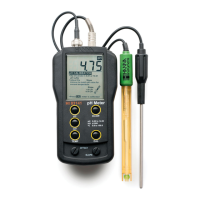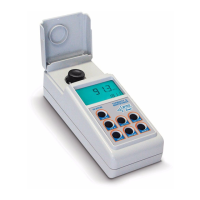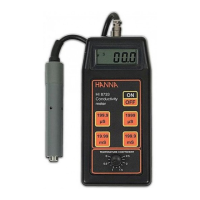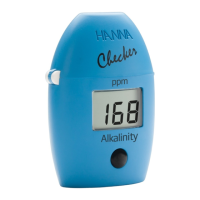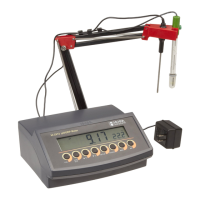58 59
Hardness Ca
CALCIUM HARDNESS
SPECIFICATIONS
Range 0.00 to 2.70 mg/L
Resolution 0.01 mg/L
Accuracy ±0.11 mg/L ±5% of reading
Typical EMC ±0.01 mg/L
Deviation
Light Source Tungsten lamp with narrow band interference filter @ 525 nm
Method Adaptation of the
Standard Methods for the Examination of Water and Wastewater,
18
th
edition,
Calmagite method. The reaction between calcium and reagents causes a
reddish-violet tint in the sample.
REQUIRED REAGENTS
Code Description Quantity
HI 93720A-0 Ca & Mg indicator 0.5 mL
HI 93720B-0 Alkali solution 0.5 mL
HI 93720C-0 EGTA solution 1 drop
REAGENT SETS
HI 93720-01 Reagents for 100 tests
HI 93720-03 Reagents for 300 tests
For other accessories see page 128.
MEASUREMENT PROCEDURE
• Select the
Calcium Hardness
method using the proce-
dure described in the
Method Selection
section (see
page 12).
• Rinse a graduated beaker several times with unreacted
sample, before filling it to the 50 mL mark with the
sample.
• Add 0.5 mL of HI 93720A-0 Calcium indicator solution
and swirl to mix.
• Add 0.5 mL of HI 93720B-0 Alkali solution and swirl
to mix. Use this solution to rinse 2 cuvettes before filling
them up to the 10 mL mark.
# 1 # 2
• Press TIMER and the display will show the countdown prior to zeroing the blank or, alternatively, wait
for two minutes and press ZERO. The display will show “-0.0-” when the meter is zeroed and ready
for measurement.
• Remove the cuvette.
• Insert the other cuvette (# 2) with the reacted sample into the
instrument.
• Press READ to start reading. The instrument displays the results in mg/L of fluoride.
Note: For wastewater or seawater samples, before performing measurements, distillation is required.
For most accurate results, use two graduated pipettes to deliver exactly 8 mL of distilled water and
8 mL of sample.
Fluoride
# 2
INTERFERENCES
Interferences may be caused by:
Alkalinity (as CaCO
3
) above 5000 mg/L
Aluminum above 0.1 mg/L
Iron, ferric above 10 mg/L
Chloride above 700 mg/L
Phosphate, ortho above 16 mg/L
Sodium hexametaphosphate above 1.0 mg/L
Sulfate above 200 mg/L
Highly colored and turbid samples may require distillation
Highly alkaline samples can be neutralized with nitric acid.

